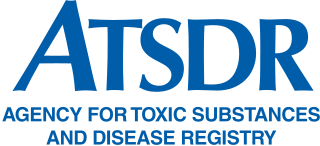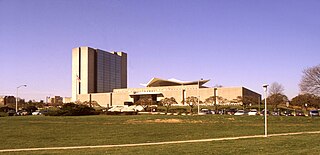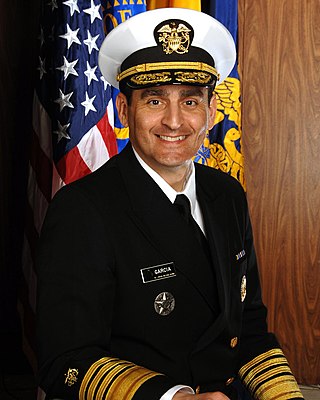Related Research Articles

The United States secretary of health and human services is the head of the United States Department of Health and Human Services, and serves as the principal advisor to the president of the United States on all health matters. The secretary is a member of the United States Cabinet. The office was formerly Secretary of Health, Education, and Welfare. In 1980, the Department of Health, Education, and Welfare was renamed the Department of Health and Human Services, and its education functions and Rehabilitation Services Administration were transferred to the new United States Department of Education. Patricia Roberts Harris headed the department before and after it was renamed.

The United States Department of Health and Human Services (HHS) is a cabinet-level executive branch department of the U.S. federal government created to protect the health of the U.S. people and providing essential human services. Its motto is "Improving the health, safety, and well-being of America". Before the separate federal Department of Education was created in 1979, it was called the Department of Health, Education, and Welfare (HEW).

The surgeon general of the United States is the operational head of the United States Public Health Service Commissioned Corps (PHSCC) and thus the leading spokesperson on matters of public health in the federal government of the United States. The Surgeon General's office and staff are known as the Office of the Surgeon General (OSG), which is housed within the Office of the Assistant Secretary for Health.

The United States Public Health Service is a collection of agencies of the Department of Health and Human Services concerned with public health, containing nine out of the department's twelve operating divisions. The Assistant Secretary for Health oversees the PHS. The Public Health Service Commissioned Corps (PHSCC) is the federal uniformed service of the PHS, and is one of the eight uniformed services of the United States.

The Agency for Toxic Substances and Disease Registry (ATSDR) is a federal public health agency within the United States Department of Health and Human Services. The agency focuses on minimizing human health risks associated with exposure to hazardous substances. It works closely with other federal, state, and local agencies; tribal governments; local communities; and healthcare providers. Its mission is to "Serve the public through responsive public health actions to promote healthy and safe environments and prevent harmful exposures." ATSDR was created as an advisory, nonregulatory agency by the Superfund legislation and was formally organized in 1985.

The United States National Library of Medicine (NLM), operated by the United States federal government, is the world's largest medical library.

The Bureau of Intelligence and Research (INR) is an intelligence agency in the United States Department of State. Its central mission is to provide all-source intelligence and analysis in support of U.S. diplomacy and foreign policy. INR is the oldest civilian element of the U.S. Intelligence Community and among the smallest, with roughly 300 personnel. Though lacking the resources and technology of other U.S. intelligence agencies, it is "one of the most highly regarded" for the quality of its work.

Julius Benjamin Richmond was an American pediatrician and public health administrator. He was a vice admiral in the United States Public Health Service Commissioned Corps and served as the United States Surgeon General and the United States Assistant Secretary for Health during the Carter Administration, from 1977 to 1981. Richmond is noted for his role in the creation of the Head Start program for disadvantaged children, serving as its first national director.
A health department or health ministry is a part of government which focuses on issues related to the general health of the citizenry. Subnational entities, such as states, counties and cities, often also operate a health department of their own. Health departments perform food inspections and other health related inspections, vaccination programs, free STD and HIV tests, tobacco enforcement and cessation programs, and other medical assistance programs. Health departments also compile statistics about health issues within their area. The role of a health department may vary from one country to the other, but their primary objective is always the same; safeguarding and promoting health. In 1986, several of the world's national health departments met to establish an international guideline by which health departments operate. The meeting was in Ottawa, Ontario, Canada, and hence the guidelines established are known as the Ottawa Charter. The Ottawa Charter was designed to 'achieve Health for All'.

Howard Kyongju Koh is the former United States Assistant Secretary for Health for the U.S. Department of Health and Human Services (HHS), after being nominated by President Barack Obama and confirmed by the U.S. Senate in 2009.

The assistant secretary for health (ASH) is a senior U.S. government official within the United States Department of Health and Human Services (HHS). The position is a statutory office and the holder of the office serves as the United States Secretary of Health and Human Services's primary advisor on matters involving the nation's public health. The assistant secretary oversees all matters pertaining to the United States Public Health Service (PHS), the main division of the Department of Health and Human Services, for the secretary and provides strategic and policy direction. The Public Health Service comprises almost all of the agency divisions of the Department of Health and Human Services including the United States Public Health Service Commissioned Corps, one of the eight federal uniformed services, comprising more than 6,500 uniformed health professionals who serve with the Department of Health and Human Services, or are assigned to work within other federal agencies, including the United States Armed Forces.
The National Science Advisory Board for Biosecurity (NSABB) is a panel of experts that reports to the Secretary of the United States Department of Health and Human Services. It is tasked with recommending policies on such questions as how to prevent published research in biotechnology from aiding terrorism, without slowing scientific progress.

Joxel García is a Puerto Rican physician and a former four-star admiral in the U.S. Public Health Service Commissioned Corps. He served as the fourteenth Assistant Secretary for Health (ASH), U.S. Department of Health and Human Services from March 13, 2008, to January 20, 2009. He served as the Director of Health in the District of Columbia. He served as the Executive Director of the MD Anderson Cancer Control and Prevention Platform and Member of the Leadership Team of the MD Anderson Moon Shots program until May 2017 before joining American Express as Vice President and Chief Medical Officer.
The Office of Population Affairs (OPA) is part of the Office of Public Health and Science in the United States Department of Health and Human Services (HHS). It is responsible for reproductive health topics, including adolescent pregnancy, family planning, and sterilization, as well as other population issues.

The Administration for Strategic Preparedness and Response (ASPR) is an operating agency of the U.S. Public Health Service within the Department of Health and Human Services that focuses preventing, preparing for, and responding to the adverse health effects of public health emergencies and disasters. Its functions include preparedness planning and response; building federal emergency medical operational capabilities; countermeasures research, advance development, and procurement; and grants to strengthen the capabilities of hospitals and health care systems in public health emergencies and medical disasters. The office provides federal support, including medical professionals through ASPR’s National Disaster Medical System, to augment state and local capabilities during an emergency or disaster.

On December 19, 2006, the Pandemic and All-Hazards Preparedness Act (PAHPA), Public Law No. 109-417, was signed into law by President George W. Bush. First introduced in the House by Rep. Mike Rogers (R-MI) and Rep. Anna Eshoo (D-CA), PAHPA had broad implications for the United States Department of Health and Human Services's (HHS) preparedness and response activities. Among other things, the act amended the Public Health Service Act to establish within the department a new Assistant Secretary for Preparedness and Response (ASPR); provided new authorities for a number of programs, including the advanced development and acquisitions of medical countermeasures; and called for the establishment of a quadrennial National Health Security Strategy.

Brett P. Giroir is an American pediatrician. He was formerly the U.S. assistant secretary for health, a four-star admiral in the U.S. Public Health Service Commissioned Corps and an acting Food and Drug Administration commissioner.
The Office of the Assistant Secretary for Planning and Evaluation (ASPE) is the principal advisory group to the United States Secretary of the Department of Health and Human Services (HHS) on policy development and provides coordination and support for HHS's strategic and policy planning, planning and development of legislation, program evaluation, data gathering, policy-related research, and regulatory program.
References
- ↑ "Office of the Assistant Secretary for Health (ASH)". 2010-09-22. Archived from the original on 2010-09-22. Retrieved 2018-10-17.
- ↑ "Office of the Assistant Secretary for Health (OASH)". HHS.gov. 2016-03-30. Retrieved 2018-10-17.
